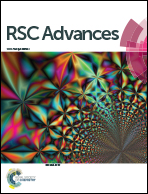Loess surface grafted functional copolymer for removing basic fuchsin†
Abstract
Loess clay (LC), a very abundant clay with granules and high hydrophilicity, was modified by surface grafting copolymerization of functional monomers, such as acrylamide (AM) and sodium p-styrene sulfonate (StS), and a cross-linking agent (N,N-methylenebisacrylamide: MBA), which afforded a LC surface grafting copolymer (LC-PAmS). Its structure and composition were characterized by Fourier transform infrared spectroscopy (FT-IR), thermal gravimetric analysis (TGA) and scanning electron microscopy (SEM). Acting as a novel and low-cost Loess-based polymer adsorbent, its adsorption behaviors were investigated with removing basic fuchsin (BF) in aqueous solution. After optimizing conditions, the removal rate got to 98.4% in 40 min at room temperature. Its adsorption mechanism was also investigated. It was found that the adsorption isotherm model could meet the Freundlich isotherm requirements and the dynamics were consistent with a pseudo-second-order kinetic model. In summary, LC-PAmS is a kind of polymer adsorbent for practically applied in wastewater treatment.



 Please wait while we load your content...
Please wait while we load your content...